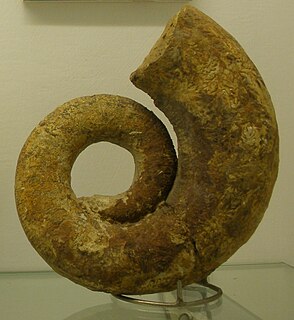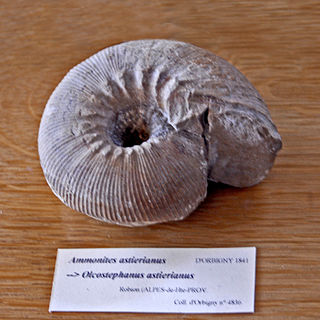
Stephanoceras is an extinct genus of Stephanoceratoid ammonite which lived during the Bajocian. It is the type genus of the family Stephanoceratidae.

Aspidoceras is an extinct ammonoid cephalopod genus belonging to the family Aspidoceratidae.

Ataxioceras is an extinct Ammonite cephalopod genus confined to the Upper Jurassic of Europe, included in the superfamily Perisphinctoidea.

Berriasella is a discoidal evolute perisphinctacean ammonite, and type genus for the neocomitid subfamily Berriasellinae. Its ribbing is distinct, consisting of both simple and bifurcated ribs that extend from the umbilical seam across the venter; its whorl section generally compressed, the venter more or less narrowly rounded. The species Berriasella jacobi traditionally has been regarded an index fossil defining the base of the Cretaceous, however since 2016 this had been replaced by the first occurrence of Calpionella alpina.

Oxynoticeratidae is a family of true ammonites included in the superfamily Psiloceratoidea.

Calliphylloceras is an ammonite belonging to the Phylloceratidae.

Requienia is an extinct genus of fossil saltwater clam, a marine bivalve molluscs in the order Hippuritida, family Requieniidae. These rudists lived in the Cretaceous period, from the Valanginian age (136.4–140.2) to the Campanian age. They were stationary intermediate-level suspension feeders.

Lytoceras is an ammonite genus that was extant during most of the Jurassic and Cretaceous periods, and is the type genus for the family Lytoceratidae. These cephalopods were fast-moving nektonic carnivores.

Pterotrigonia is an extinct genus of saltwater clams, marine bivalve molluscs in the family Megatrigoniidae. This genus is known in the fossil record from the Jurassic period Tithonian age to the Cretaceous period Maastrichtian age. Species in this genus were facultatively mobile infaunal suspension feeders. The type species of the genus is Pterotrigonia cristata.

Phyllopachyceras is an extinct genus of ammonoid cephalopods belonging to the family Phylloceratidae. These nektonic carnivores lived in the Cretaceous, from Hauterivian to Maastrichtian to age.

Eulytoceras is an extinct genus of ammonoid cephalopods belonging to the family Lytoceratidae. These fast-moving nektonic carnivores lived in the Cretaceous period, from Hauterivian age to Barremian age.

Pseudothurmannia is a genus of extinct cephalopods belonging to the subclass Ammonoidea and included in the family Crioceratitidae of the ammonitid superfamily Ancylocerataceae. These fast-moving nektonic carnivores lived in the Cretaceous period, from Hauterivian age to Barremian age.

Harpoceras is an extinct genus of ammonite belonging to the family Hildoceratidae. These cephalopods existed in the Jurassic period, during the Toarcian age from the Falciferum zone to the Commune subzone of the Bifrons zone. They were fast-moving nektonic carnivores.

Reineckeia is an extinct genus of ammonoid cephalopods belonging to the family Reineckeiidae.

Silesites is an ammonite genus placed in the family Silesitidae. Species in this genus were fast-moving nektonic carnivores. They lived during the Cretaceous, in the Barremian age. The type species of the genus is Silesites seranonis .

Oosterella is an extinct ammonoid cephalopod genus belonging to the family Oosterellidae. These fast-moving nektonic carnivores lived during the Cretaceous, from the upper Valanginian age to the lower Hauterivian age.

Olcostephanus is an extinct ammonoid cephalopod genus belonging to the family Olcostephanidae. These fast-moving nektonic carnivores lived during the Cretaceous, from the upper Valanginian to the lower Hauterivian age.

Cardioceras is an extinct ammonite genus belonging to the family Cardioceratidae. These fast-moving nektonic carnivores lived during the Jurassic period, Oxfordian age.

Skirroceras bayleanum is a Stephanoceratacean (ammonite) species belonging to the family Stephanoceratidae.

Skirroceras macrum is a Stephanoceratacean (ammonite) species belonging to the family Stephanoceratidae.




















